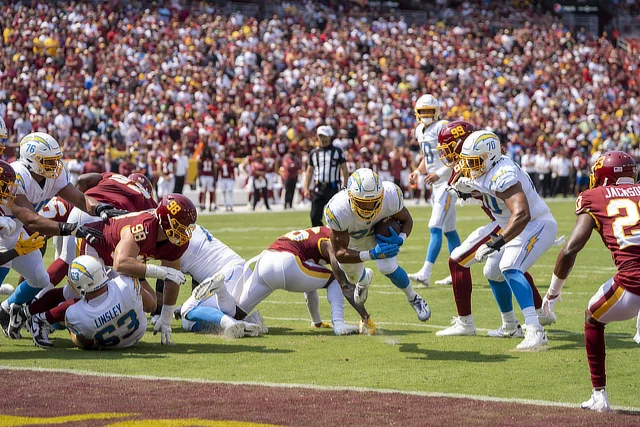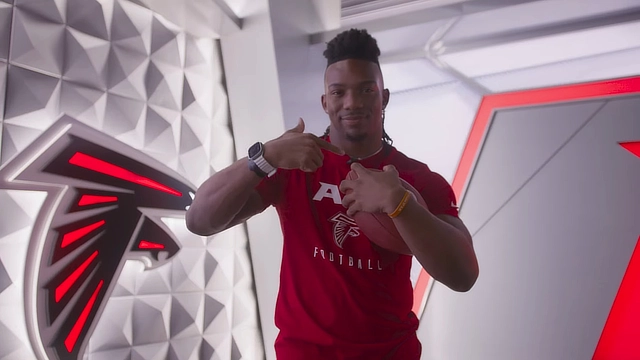
"LAC running back makes a play" by All-Pro Reels is licensed under CC BY-SA 2.0.
An established veteran running back or an untested rookie? It sounds like an easy choice, but come playoff time, that rookie could be destroying your team in the fantasy football Super Bowl. Rookies are more unpredictable than veterans because it is impossible to tell how players will adjust to the bigger and faster pro level. Some players adapt immediately, like Saquon Barkley in 2018 when he finished as the overall RB1 in his rookie year, but is it worth the inherent risk of drafting a player that has not even taken a professional snap?
I analyzed how past running backs have lived up to expectations in each year of their careers to find out the answer.
The Methodology
Finding value is the most important thing in fantasy football, especially the draft. Value is not just how well a player performs. Value measures how well a player produces compared to their preseason expectations. The goal is to draft players that finish with an end-of-season ranking (EOSR) better than their initial draft spot. If a player ends up ranked better than expected at the end of the season, then that player was a good value draft pick. That’s why the experts always talk about the upside players have.
To find out which year of NFL experience yields the best fantasy football value, I looked at how often players finish above or below their average draft position (ADP), which is the average spot where a player is selected in fantasy football drafts.
I also looked at the frequency that players have a “boom” season versus how often they have a “bust” season. Players having a boom season perform far better than expected. These players can leverage matchups in your favor every week and win championships at the end of the season. Players having a bust season do the opposite. They can derail your entire season and help you claim whatever last-place prize your league has come up with. They might not even be on your team’s roster at the end of the season.
To get a good sample size, I included every running back with a preseason ADP within the bounds of being drafted in the average 12-team league, which usually means about the top 60 running backs. I collected data for these players over five seasons, creating a sample of 290 running backs. All the rankings and data are collected according to a regular full-point-per-reception (PPR) league format.
Which Year of Experience Typically Has the Best Value for Fantasy?

On average, the typical running back will have an EOSR that is better than his ADP 40.7% of the time. Rookies, on the other hand, finish better than their ADP 52.4% of the time. That is the best of any year. To ensure that rookies with a low ADP were not skewing the data, I looked at the same statistics but only included players who had an ADP of 36 or higher among running backs, meaning they would start on the average fantasy team. When projected starters are the only ones included, rookies taken in the top 36 running backs finish better than their ADP by an even more drastic 58.8% compared to the average of 41.1%. It should go without saying that rookies were also the best among all running backs in that category.
The graph below shows the relationship between a player’s year of experience in the NFL and the percentage of time the typical player finishes with a better EOSR than preseason ADP.

As players age, there is a clear regression in performance in comparison to preseason expectations, and rookie running backs outperform other years of experience by a significant amount.

It is worth noting that rookie running backs miss one less game due to injury on average than veteran backs (1.56 games per season compared to 2.61 as the veteran average), so their EOSR benefits from that.
To take away this possible reason for rookie success, I analyzed the rankings on a per-game basis. The points-per-game EOSRs do not take games missed into account, and once again, rookie running backs lead that category by finishing with a points-per-game ranking better than their ADP 50% of the time compared to the average of 38.5%. When looking at just starters, rookies also lead that category with 58.8% compared to the mean of 41.7%.
Which Year of Experience Has the Most League-Winner Caliber Players?
A player that finishes above ADP by a ranking spot or two is valuable for your fantasy team, but nobody would call that player a league-winner. To find out which players make the difference, good or bad, in fantasy football, I found out which players were booms and which were busts.

In theory, a player is expected to finish where they were drafted. That’s why they were drafted there. So, to be considered a boom player, a player had to finish at least 40% better than expected and at least six spots better than expected. If a player finished 40% worse than expected and at least 12 spots worse than expected, they registered as a bust.

For once, rookies did not have the best boom or bust percentage. Rookies came in with the second-highest boom percentage and the third-lowest bust percentage. Both were on the good side of the average, but it’s hard to say rookies were the best in this case. The year of experience with the highest risk/reward was year five with the boom chance at 30.4% and the bust chance at 34.5%.
In this model, the y-axis shows the boom percentage, and the x-axis shows the bust percentage. Each point shows the boom/bust relationship for a year of experience. The points in the top-left quadrant have the most desirable results because they have an above-average boom percentage and a below-average bust percentage. The top-right quadrant shows a high-risk, high-reward chance; the bottom-left quadrant shows a low-risk, low-reward chance; and the bottom-right quadrant shows a high-risk, low-reward chance.
Are First-Year Backs Good Picks in the First Round or as RB1s?
There’s a saying in fantasy football: You can’t win your league in the first round, but you can lose it. Typically, your best running back is going to produce like a top running back, so the trick to drafting a top running back is to draft one that won’t let you down.
To get an adequate sample size, I gathered information from the past ten years of RB1-drafted players, which means running backs that were drafted in the top 12 at the position. In that time, only five rookies were drafted in the top 12, and only one of them, Clyde Edwards-Helaire, finished below his ADP. He also registered as a bust due to his draft spot as a mid-RB1 (7 among RBs) and his finish as a low-end RB2 (22 among RBs). Edwards-Helaire is a blemish on an otherwise perfect record in the past ten years with the other four players – Ezekiel Elliott (2016), Saquon Barkley (2018), Leonard Fournette (2017), and Najee Harris (2021) – all finishing above their ADP, including three of them finishing in the top three running backs.
When looking at the data for all non-rookie, RB1-drafted players, players in years four and six have the best numbers. They both have below-average bust percentages, making them safe options for top-tier draft picks, and they also finish better or at the same ADP an above-average percentage of the time.
Should I Draft Bijan Robinson at His First Round ADP?
 "Atlanta Falcons Bijan Robinson MAY2023" by Atlanta Falcons is licensed under CC BY 3.0.
"Atlanta Falcons Bijan Robinson MAY2023" by Atlanta Falcons is licensed under CC BY 3.0.This year, the big prospect is Texas’ Bijan Robinson. Bijan landed with the Falcons, who ran the ball 32.9 times per game (2nd in the NFL) in 2022, which means that even though second-year back Tyler Allgeier will take carries away from Bijan, there are still plenty of carries to go around. It also helps that the Falcons have the 7th best offensive line in the Pro Football Focus rankings, and CBS Sports ranked their schedule as the easiest in the NFL. As I mentioned before (2022 Breece Hall owners look away), rookie running backs also miss fewer games due to injury than veterans on average, so it is more likely that drafting a rookie will reduce the chance that injuries keep you away from the Super Bowl. Depending on Bijan’s ADP come draft time, he should be a fantastic first-round selection.
Conclusion and Draft Strategy
Running backs are unique in that they seem to adjust faster than other positions in the NFL, but their careers are typically shorter, as evidenced by the downward trend in data and the shrinking sample size as the years increased. To use this data in your fantasy draft, I strongly recommend targeting rookies as low-risk options with favorable upside. When drafted at or after their ADP, rookies have shown remarkable consistency without sacrificing their potential to exceed expectations. In general, the data in the boom/bust section does not show good enough results to recommend drafting rookies before their ADP or reaching for them, but the data at ADP is strong enough to merit picking a rookie over a veteran based on ADP value.
About the Author
 Drew Castleberry is a sophomore in the Brock School of Business at Samford University with an interest in sports analytics.
Drew Castleberry is a sophomore in the Brock School of Business at Samford University with an interest in sports analytics.
Citations
National Football League. (2023, June 20). Official NFL Injury Report for Players.
FantasyPros. (2023, June 17). Fantasy Football Leaders.
ESPN. (2023, June 17). ESPN Live Draft Trends.
Fantasy Football Calculator. (2023, June 17). Average Draft Position.
"Atlanta Falcons Bijan Robinson MAY2023" by Atlanta Falcons is licensed under CC BY 3.0.
